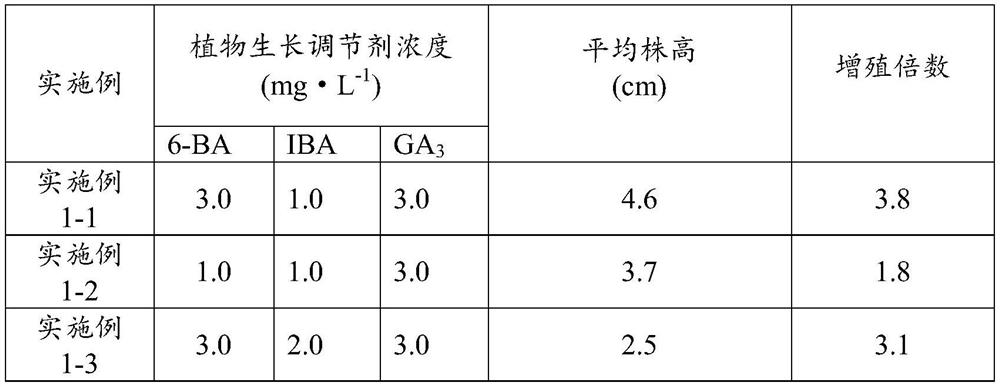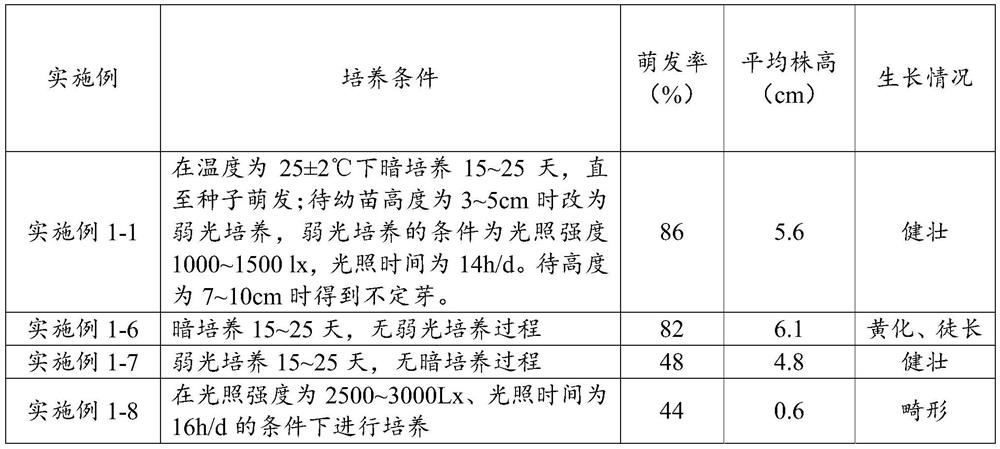A kind of tissue culture method of linden seedlings
A technology for tissue culture and seedlings, applied in horticultural methods, botany equipment and methods, plant regeneration, etc., can solve the problems of no tissue culture methods for Tilia montina seedlings, and achieve the purpose of avoiding the spread of diseases and insect pests, shortening the breeding cycle, and improving the breeding quality. The effect of the coefficient
- Summary
- Abstract
- Description
- Claims
- Application Information
AI Technical Summary
Problems solved by technology
Method used
Image
Examples
Embodiment 1-1
[0056] (1) Mix the linden seeds with fine sand in a weight ratio of 1:3, and rub gently until the surface of the seeds is rough. Separate the seeds and fine sand, wash the seeds with clean water, put them in a cup, and soak them in distilled water for 3 days.
[0057] (2) Filter and dry the seeds soaked in step (1), add concentrated sulfuric acid at a volume ratio of 1:1 between seeds and concentrated sulfuric acid, and soak for 3 minutes, stirring continuously during this period. After pouring out the sulfuric acid, carefully rinse with clean water until there is no residue, and then soak in sterile water overnight. Repeat the above steps 1 time.
[0058] (3) In the ultra-clean workbench, first soak the seeds treated in step (2) with an alcohol solution with a volume fraction of 75% for 40 seconds, then wash with sterile water for 3 to 5 times, and then use a solution with a mass concentration of 2 % sodium hypochlorite solution for 10 minutes, and then rinsed with sterile ...
Embodiment 1-2 to Embodiment 1-5
[0064] Change the type and amount of reagents in the subculture medium in step (3), and observe the effects of different hormone combinations on the reproductive coefficient of adventitious buds of Tilia montana. The dosage of sucrose and agar, and the cultivation method are the same as those in Example 1-1, and the results are shown in Table 1. Wherein, the multiplication factor=the total number of proliferation of explant growth points / the total number of differentiated explants, which is calculated by the method of calculating the average value.
[0065] Table 1
[0066]
[0067]
[0068] As can be seen from Table 1, compared with embodiment 1-1, change 6-BA, IBA and GA 3 The average plant height and multiplication factor of Tilia mongolica seedlings decreased. Therefore, for the subculture step, the most suitable subculture medium formula is WPM+3.0mg / L of 6-BA+1.0mg / L of IBA+3.0mg / L of GA 3 .
Embodiment 1-6 to Embodiment 1-8
[0070] Change the light conditions during the induction culture in step (2), and other culture methods are the same as in Example 1-1. See Table 2 for the effects of observing the germination rate, average plant height and growth of Tilia mongolica.
[0071] Table 2
[0072]
[0073] As can be seen from Table 2, dark culture and weak light culture are carried out successively in the induction process, and the germination rate of Tilia mongolica seeds is high, and the growth is robust; simple dark culture can easily cause seedlings to grow excessively and yellow, and are easy to die in the later stage; only low light is used The germination rate of cultured seeds is reduced; and strong light culture is not conducive to the growth of seedlings, making the seedlings short and deformed.
PUM
 Login to View More
Login to View More Abstract
Description
Claims
Application Information
 Login to View More
Login to View More - R&D
- Intellectual Property
- Life Sciences
- Materials
- Tech Scout
- Unparalleled Data Quality
- Higher Quality Content
- 60% Fewer Hallucinations
Browse by: Latest US Patents, China's latest patents, Technical Efficacy Thesaurus, Application Domain, Technology Topic, Popular Technical Reports.
© 2025 PatSnap. All rights reserved.Legal|Privacy policy|Modern Slavery Act Transparency Statement|Sitemap|About US| Contact US: help@patsnap.com



